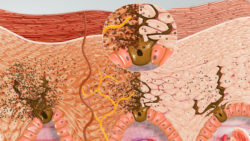
Functions of the Skin
The skin, being the largest organ in surface area and weight has a few extremely important functions.- Protection The skin acts as a barrier and provides protection from temperature variations, bacteria and micro-organisms, chemicals, radiation and pressure.
- Regulation The skin helps in regulating the body temperature through sweat and hair, and also maintains peripheral circulation of fluids through sweat.
- Vitamin D The skin helps in synthesising Vitamin D.
- Sensation The skin, through its extensive network of nerve cells, communicate sensations such as heat, cold, pleasure and pain.
- Control of evaporation The skin also provides a sufficient barrier to loss of fluids from the body.
Skin conditions
There are a large number of diseases and conditions related to the skin. Some chronic skin conditions are Acne, Rosacea, Eczema, Psoriasis, warts, dandruff, skin abscess, herpes, hives, rash, scabies, ringworm. Some of these may not be curable but can be managed with proper medication and a healthy lifestyle. Melanoma is the most common type of skin cancer which results from skin damage.Treatment of Skin conditions
To treat the various conditions of the skin, different types of medicines may be used. Corticosteroids, antiviral drugs, antibiotics, antifungal drugs, antihistamines, and immune modulators are some of the common medications that are used. In some cases, where the skin gets dry and itchy, moisturisers are sufficient to treat the condition.Sources-
- https://www.healthline.com/health/function-of-bone-marrow
- https://www.webmd.com/skin-problems-and-treatments/picture-of-the-skin
- https://www.britannica.com/science/human-skin

The Chemistry of Skin Tanning
The sun, water, air - the elements - are double-edged swords for humans. In moderation, they sustain planetary life. But they can also be dangerous. The human body’s machinery harvests the elements to produce nutrients or run internal processes. But it also has defenses against excess exposure to the elements. Versus the sun, this defence is the process of melanogenesis, or skin tanning. Read More..Test what you learned








